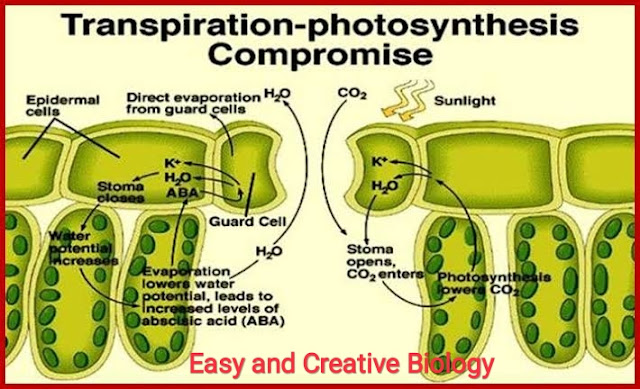Transpiration - Definition, Process, Types, Structure of Stomata - Easy and Creative Biology
Transpiration and Structure of Stomata:
 |
| Transpiration - Definition, Process, Types, Structure of Stomata - Easy and Creative Biology |
Transpiration is the process in which plants release the water inside it in the form of moisture or water vapor. Roots consume some amount of water from the soil and the rest evaporates in the atmosphere. Parts of plants such as stems, small pores on leaves, and flowers evaporate the water to the atmosphere. In other words, it is the process in which water evaporates in the atmosphere from plant leaves and other parts. Let us study more about it.
 |
| Transpiration - Definition, Process, Types, Structure of Stomata - Easy and Creative Biology |
Types of Transpiration:
Depending on the organ that performs transpiration, the different types are:
Stomatal transpiration: It is the evaporation of water through stomata. Stomata are specialized pores in the leaves. They account for around 80 to 90% of the total water loss from the plants.
Cuticular transpiration: Cuticle is an impermeable covering present on the leaves and stem. It causes around 20% of transpiration in plants. Cuticular transpiration is lesser in xerophytes because they have thicker cuticles.
Lenticular Transpiration: It is the evaporation of water through lenticels. Lenticels are the tiny openings present on the woody bark.
Leaves absorb visible and invisible radiations of the sun. And so, get heated up. As a result, water vaporizes and is given out in the atmosphere. This, in turn, brings down the temperature of the leaves. The opening and closing of stomata regulate transpiration.
 |
| Transpiration - Definition, Process, Types, Structure of Stomata - Easy and Creative Biology |
Structure of Stomata:
Stomata are the tiny pores present in the epidermal surface of leaves. Two kidney-shaped cells known as guard cells, guard the pores. The inner wall of the guard cell towards the stomata is thicker as compared to the outer walls. Also, the peculiar arrangement of the microfibrils of the guard cells aids in opening and closing of the stomatal aperture.
The orientation of microfibrils is radial rather than longitudinal. This helps stomata to open easily. In a dorsiventral dicotyledonous leaf, the number of stomata on the lower surface is higher when compared to the upper surface. This adaptation helps in reducing the evaporation of water. In isobilateral leaf in a monocotyledonous plant, the number of stomata is equal on both the surfaces.
 |
| Transpiration - Definition, Process, Types, Structure of Stomata - Easy and Creative Biology |
Factors affecting Transpiration:
Transpiration rate depends on various factors such as:
1)Environmental factors like
2)temperature
3)relative humidity
4)wind speed etc.
5)Plant factors like
6)the number and distribution of stomata.
7)Percentage of open stomata.
8)Water status of the plant.
9)The structure of canopy of the tree.
 |
| Transpiration - Definition, Process, Types, Structure of Stomata - Easy and Creative Biology |
Mechanism of Stomatal Movement:
The factors which affect stomatal movement are-
1)Amount of light
2)The concentration of carbon dioxide
3)Water supply
4)The opening and closing of stomata operate as a result of turgidity changes in the guard cells. During the daytime, the guard cells perform photosynthesis due to which osmotic pressure increases. Thus, the guard cells absorb water from the neighboring cells. As a result, the guard cells become turgid. Furthermore, the outer thin walls of guard cells are pushed out and the inner thicker walls are pulled inwards resulting in stomata to open. During the night time or in a condition of water scarcity or dry areas, guard cells are in a flaccid state and remain closed.
Ascent of Sap :
Transpiration is the essential driving force for the ascent of sap (rising of water in the tall trees through xylem vessels). The ascent of sap depends upon the following
physical properties of water:
Cohesion-It is the attraction between water molecules.
Adhesion– The water molecules get attached to the surface of the tracheary elements of xylem.
Surface tension– The ability of water surface to behave like a stretched membrane.
These properties give water high tensile strength and high capillarity. Because of this, the water can rise in vessels and tracheids of the xylem of tall trees. As the water is lost from the leaves during transpiration, a pulling action is generated due to which the water rises high in the tall trees. The force generated by transpiration can create pressure sufficient to lift the water over 130 M high.
Transpiration and Photosynthesis – A Compromise
Transpiration is an important phenomenon because
It’s pulling action helps in the absorption and transportation of water in the plant.
It supplies water for photosynthesis.
Transpiration cools the leaf surface.
It maintains turgidity of the cells.
Water and carbon dioxide are important for photosynthesis. Stomata are kept open for exchange of gases during the day. But it leads to a lot of loss of water. So plants get depleted of water due to continuous transpiration. Besides, C4 plants might have evolved to reduce the evaporation of water due to transpiration. Because they can maintain a constant supply of CO2 even after the closing of stomata.
Solved Questions for You.
Solved Questions for You.
Q1. Transpiration is a necessary evil in plants. Explain.
Ans: Transpiration causes huge loss of water. It reduces photosynthesis, lowers growth and may cause wilting of the plant. Despite all these disadvantages, it is necessary. Because it provides the pulling action for water to rise in the trees. It also maintains the temperature.
Q2. The C4 plants are twice as efficient as C3 plants in terms of fixing CO2. But they lose only half as much water as C3 plants for the same amount of CO2 fixed. Explain.
Ans: This is because C4 plants regulate a constant supply of CO2 and keep their stomata closed for some time. As a result, reduces the loss of water.



